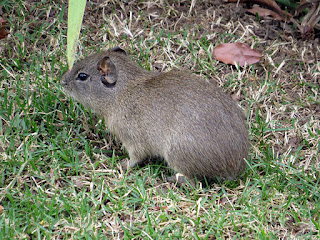August 17,
2015
I had just
two nights in Cuiabá after my tour, not nearly enough time to catch up on
emails, process photos, and do post-tour materials. But I did find a place to
get my hair and beard cut a 15-minute walk from the hotel, and paid daily
visits to the ATM to stock up on reais
for the upcoming tour. All the participants arrived on time, as did Fabrice
Schmitt, my co-leader for this group of 11 participants for the next two weeks.
Here’s Fabrice Schmitt, my friend and co-leader, and one of South America’s most adventuresome and accomplished birders.
We’ve had a
great start in the Chapada dos Guimarães, just like the last tour had, but
distinctly different. Last time we had a super cooperative Collared
Crescentchest and had to practically beat the Chapada Flycatchers away with our
tripods. This time the same crescentchest wasn’t so cooperative, and we
couldn’t buy a Chapada Flycatcher. In fact, yesterday afternoon we found the
more widespread Suiriri Flycatchers (Campo Suiriri), a very close relative, and
my first one here.
But
White-banded Tanagers were even more cooperative this time, such as this one on
a fence.
This Campo
Flicker was one of a pair that greeted us yesterday morning on our
pre-breakfast outing to the short scrub that harbors so many specialties.
We also had
Curl-crested Jays here (no sign of them on the last tour), as well as
Spot-breasted Puffbird. Every outing is different, one reason we all continue
to watch birds.
Because of
the timing of flights, we had a bit more time on our hotel grounds at Pousada
do Parque, and we had this silent Planalto Slaty-Antshrike on the first afternoon’s
walk.
A pair of
Tropical Screech-Owls are nesting in a cavity below eye-level in a tree in the
garden, and we could peer in and see the female with at least one large chick.
But after dinner last night, this one was by the restaurant, presumably hunting
rodents coming to the papaya remnants left by birds below the tree. It allowed
us to approach within a couple feet.
But this
Tropical Screech-Owl was a quarter mile away this morning, undoubtedly a
different territory. I had used a recording I made two years ago in the
Pantanal to try to stir up a mob, as there were a few flycatchers and a calling
Band-tailed Manakin we hadn’t seen yet. But before long, this larger bird flew
in abruptly but silently at eye-level and perched next to the road, just within
a few feet of the group. We were flabbergasted.
On another
walk we had this Philaethria dido,
Southern Green Longwing.
And this Amethyst
Woodstar perched up during a session of Ferruginous Pymgy-Owl imitations (which
also brought in a Ferruginous Pymgy-Owl).
Oddly, the
Crab-eating Foxes which were so easy on the last tour were very elusive this
time, but I did at least get a photo of the Cavia
aperea, Brazilian Guinea Pigs, that forage on the grass by the pool.
And we found
out about this Coendou prehensilis, a
Brazilian Porcupine, that frequents the coconut palm by the pool but appears
only after 10:00 each evening.
I was
excited to come across this Passiflora
mansoi in bloom, the first time I’ve seen one since my first visit here in
2006. It’s a very strange passionflower in being a slender, scraggly woody
shrub with weak stems, nothing like the tendril-clad, climbing vines of so many
other species. I suspect it’s very common here but blooms only with recent
rains which become common only later in the year.
On our full day
here yesterday we stayed until sunset on the Cavernas de Aroe Jari road, where
Greater Rheas and Red-legged Seriemas continued to be reliable.
On our way
to the airport this morning – we’re headed to Cristalino Jungle Lodge – we made
one last stop in the Chapada where one of our group spotted this Tropidurus torquatus, an Amazon Lava
Lizard.


















No comments:
Post a Comment